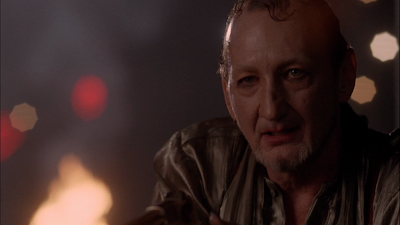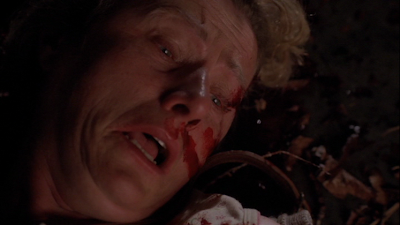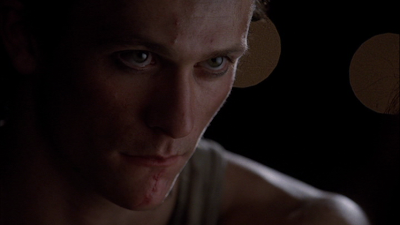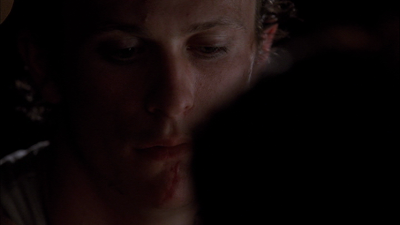Hooper, quoted from the 'Texas Chainsaw Massacre 2" DVD commentary:
"This kind of a thing I wanted... and have been doing recently with film... taking it into a kind of-- almost opera. I'm not talking about characters singing, but I'm talking about a dramatic scenario that is traveling in your 'mind-process,' with music, that helps the aperture expand. There's quite a few stylistic things in this, and my director friends totally appreciated this film in its day, and you would be surprised at the names that I could mention that this is their favorite film."... Hooper in a refreshing, surprise moment of haughty, overweening [and deserved, so far as it's seen in these parts] self-aggrandizement.
(Then he adds on - addressing the commentary moderator, horror filmmaker David Gregory - with a little laugh, "Or maybe you wouldn't be surprised." What on earth he's getting at is anyone's guess -- especially since, of course, he gives no names.)
Also, bless him, Hooper in typically less-than-articulate manner... "mind-process" elicits a laugh, and sparsely he tries to push the pretentious "mental aperture" analogy of his (always in regard to how music or an evoked musicality is utilized in film) that he almost-identically recites in his "Dance of the Dead" commentary...
It's always a bit of an effort for me to discuss 'Texas Chainsaw Massacre 2.' I don't often think of it. I feel quite indifferent to it a lot of the time, as in I am not passionate about it. As much as Hooper brings to the table in the film, the resulting product is largely silly and tonally undiscerning, played to a hilt of mind-numbing frenzy and, as a result, frankly sloppy, and one would like to attribute much of the film's failures to an [all-too-characteristic, for Hooper] ill-managed production that suffered from script overhauls (Invaders from Mars also was a victim of a complete script overhaul immediately before production was to start), constant cuts and rewriting, and a compromising production schedule (not to mention it being a project Hooper at first wished to hand off to another director). Let me get this out officially here and now that I really hate that entire sequence of Stretch inside the Saywers' meat shed: the horrendously inane interaction between Stretch and Leatherface (that mindless nonsense involving putting L.G.'s sliced-off face on her); the infinitely stupid dance they have; the unbearable schlockiness of showing off Tom Savini's FX skinning job on L.G.'s poor body; I could go on. All of it is horrifically pointless - Hooper ladles on a logy, weepy death scene, but it's absolutely graceless in the face of such a farcical and meaningless narrative sideline - and I have often longed to provide a "Fan Cut" with this entire stretch of film tossed out (... and with the deleted "Night Hunt" scenes added back in... taking out those scenes, which I think could have been a pretty damn integral part of the film's thematic tableau, is perhaps the one decision I cannot put faith in Hooper for making).
But TCM 2 can be fantastic, and a whole river flow of fantastic is set off at the moment pictured at top (also the moment Hooper says the words excerpted). This is the moment where exactly that "opera" Hooper mentions goes into play, and it essentially lasts throughout the rest of the film - that is to say, it all builds up to the film's climactic (and stupendous) set-piece of the "Dinner scene," where Hooper's effervescent character blocking, dollying camera, and disorienting subversion of conventional shot flow and directionality come to their operatic apex, emphasizing the hysterical extravagance and puffed-up grandeur of the Sawyers' updated, of the times, but ironically, somehow, now even more retrograde traditions.
Before that, though, Stretch's reluctant interloping and witnessing of a depraved living is evinced with equal inspiration, musicality, and textural richness.
Also served with gusto is the essence of the depraved living: that of the dynamic of three manically psychopathic men who roam their abode like they own the place, skittering frantically into empty or partially filled spaces (i.e. cinematic frames), mindless of the closely tracking camera.
The use of the edge of the frame -- Bodies moving into each others' frames










Perspective and the interaction of spaces







(I love this moment where Stretch just sort of mindlessly walks away from the attention of Leatherface, who is literally fazed out of the shot via the focus mechanism as she turns away from him. Obviously it is her traumatized state, but feeling the moment further, it is also clearly the noncommittal maneuver of a snooty girl so out of an interested boy's league.)
Interaction of spaces

(The erratic prancing about of the unruly Chop-Top is a recurring element of this scene. His unacknowledged, or "one-sided" - either he does not notice the other characters or they do not notice him - entrance into the foreground or background of shots established for other characters suddenly becomes a life-and-death, high moment of suspense here.)


(The fire extinguisher comically announces him.)





















































































































































